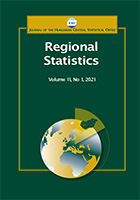Impact of land use and land cover change on the environmental quality of a region: A case of Ernakulam district in Kerala, India
Impact of land use and land cover change on the environmental quality of a region: A case of Ernakulam district in Kerala, India
Author(s): Sruthi Krishnan V., Mohammed Firoz C.Subject(s): Social Sciences, Economy, Geography, Regional studies
Published by: Központi Statisztikai Hivatal
Keywords: spatial mapping; remote sensing; entropy method; environmental quality index (EQI); Regional environmental planning
Summary/Abstract: The increasing urbanisation trend over the decades has resulted in the rapid transformation of land use and land cover (LULC) patterns worldwide. One of the significant consequences of such an uncontrolled conversion process is on the environmental quality (EQ) of the regions, which needs to be addressed. Hence, the present study attempts to derive the environmental quality index (EQI) to measure the impact of LULC along a rapidly urbanising region. The study was divided into three phases. Firstly, the relevant variables were systematically identified from the literature and screened based on relevance, redundancy, context, and scale of the study. The variables then were finalised based on data availability and expert suggestions. The selected variables were grouped under biophysical, LULC, and socio-economic domains. Secondly, using remote sensing and geographic information system (GIS) techniques, LULC analysis was performed and the bio-physical variables were processed. The LULC maps (with five classes: waterbody, settlements, hill, forest, and agriculture) were prepared for the study region for 2000,2009, and 2019 from Landsat images using a supervised classification algorithm. The LULC analysis showed an increase in the settlement over the past two decades. The relationship between the bio-physical indicators, namely, land surface temperature (LST), normalised difference vegetation index, and normalised difference built-up index (NDBI), was also established to examine the general perception that the increase in urbanisation is one of the main causes for the increase in LST of a region. The correlation indicated that the LST increased with a reduction in vegetation area and growth in settlement areas. Finally, the EQI was constructed using the entropy method of weighting. The spatial mapping of the EQ of the region was obtained and planning interventions were discussed. The EQI map demonstrated that the areas with more industrial belts had poorer EQ compared with other areas. The study also revealed that the conversion of the land cover into different land use types has led to the poor EQ of the region. The insights from the study can help the planners, administrators, and policymakers to make informed decisions regarding the EQ of a region and future urban construction activities in an area.
Journal: Regional Statistics
- Issue Year: 11/2021
- Issue No: 02
- Page Range: 102-135
- Page Count: 34
- Language: English

